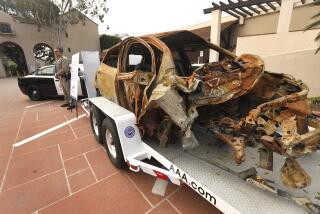Drunk Driving Deaths in U.S. Rose in 2001, MADD Reports
- Share via
WASHINGTON — The number of drunk driving deaths in the United States rose last year after holding steady during most of the 1990s, Mothers Against Drunk Driving said Thursday.
There were 17,448 drunk driving deaths in 2001, up from 16,572 in 1999, the last time MADD conducted its “Rating the States” survey. The organization graded the nation with a C -- down from a C-plus in 1999 -- with California ranking the highest with a B-plus, and Montana flunking.
MADD President Wendy Hamilton blamed the increase on complacency.
“We’ve got about 300 people getting killed every single week in this country in completely preventable crashes,” Hamilton said.
Nationally, alcohol-related traffic deaths dropped by 40% from 1980, when MADD was formed, to 1993. The number of deaths hovered around 16,500 from 1994 to 1999.
“The war on drunk driving stalled,” Hamilton said Thursday.
The grades are based on the number of alcohol-related crashes in each state, trends in the number of deaths, state laws on the books and enforcement efforts.
After California, other states that got high marks include Georgia, New York, North Carolina and Oregon, which all received B grades.
Montana was the only state to flunk. Hamilton said it was the first time a state received an F since the group began rankings a decade ago.
She called Montana “abysmal,” noting the number of alcohol-related crashes in the state, its failure to set 0.08% as the legal blood-alcohol limit and a lack of support for making failure to wear a seat belt a primary traffic violation.
Last year, 104 of Montana’s 230 traffic deaths came in alcohol-related crashes, MADD said.
Dave Galt, director of the Montana Department of Transportation, said that he is concerned about that number but that the state is working to lower it.
Galt said he expects the Legislature will consider lowering the blood-alcohol level from 0.1% next year and imposing a statewide ban on open containers of alcohol in vehicles.
“I’m not proud of being ‘F,’ ” Galt said. “I take that very seriously.”
Galt said he disagreed with how the report described the state’s efforts to fight drunk driving, pointing to state funding of efforts to reduce underage drinking and to set up visible sobriety checkpoints.
Montana was joined at the bottom of the list by Alaska and Massachusetts, which received D-minus grades, and North Dakota, Rhode Island, South Dakota and South Carolina, which received Ds.
MADD’s recommendations to reduce fatalities include more and well-publicized sobriety checkpoints. It also urged tougher penalties against drivers who refuse alcohol tests, who are caught driving with a license that was suspended for an earlier drunk driving arrest or who have a blood-alcohol level of 0.15% or more.
One group, the Governors Highway Safety Assn., criticized the MADD report, saying states should be judged on how they measure up against their own goals rather than against each other.
More to Read
Sign up for Essential California
The most important California stories and recommendations in your inbox every morning.
You may occasionally receive promotional content from the Los Angeles Times.













